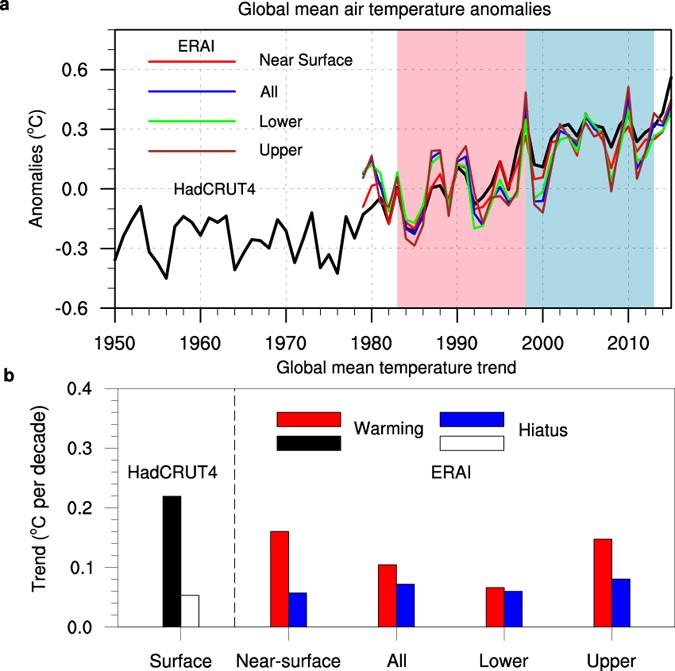Study reveals the atmospheric footprint of global warming hiatus

(a) Global mean temperature anomalies from 1950 to 2015 and (b) linear trends of global mean temperature for near surface (i.e. the lowest atmospheric layer), and the vertical average of the whole (surface to 100hPa), lower (surface to 500hPa), and upper troposphere (500hPa to 100hPa). Red (black) bars are for the warming period. Blue (white) bars are for the hiatus period. Credit: Liu and Zhou
In a recent paper published in Scientific Report, LIU Bo and ZHOU Tianjun from the Institute of Atmospheric Physics, Chinese Academy of Sciences have investigated the atmospheric anomalous features during the global warming hiatus period (1998-2013). They show evidences that the global mean tropospheric temperature also experienced a hiatus or pause.
To understand the physical processes that dominate the warming hiatus, they decomposed the total temperature trends into components due to processes related to surface albedo, water vapor, cloud, surface turbulent fluxes and atmospheric dynamics.
The results demonstrated that the hiatus of near surface temperature warming trend is dominated by the decreasing surface latent heat flux compared with the preceding warming period, while the hiatus of upper tropospheric temperature is dominated by the cloud-related processes. Further analysis indicated that atmospheric dynamics are coupled with surface turbulent heat fluxes over lower troposphere and coupled with cloud processes over upper troposphere.
As to why the surface latent heat flux, atmospheric dynamics and cloud-related processes showed such large differences between 1983-1998 and 1998-2013, LIU, first author of the paper, explained, “They are dominated by the Hadley Circulation and Walker Circulation changes associated with the phase transition of Interdecadal Pacific Oscillation (IPO).”
According to LIU, the IPO is a robust, recurring pattern of sea surface temperature anomalies at decadal time scale. During a positive phase of IPO, the west Pacific and the mid-latitude North Pacific becomes cooler and the tropical eastern ocean warms, while during a negative phase, the opposite pattern occurs. The IPO has shifted from the positive phase to negative phase since 1998/1999, and this transition has led to the weakening of both Hadley Circulation and Walker Circulation, which served as a hub linking the three processes mentioned above.
“Though the heat capacity of the atmosphere is nearly negligible compared with the ocean”, said ZHOU, corresponding author of the paper, “understanding the atmospheric footprint is essential to gain a full picture of how internal climate variability such as IPO affects the global climate from the surface to the troposphere. The new findings also provide useful observational metrics for gauging climate model experiments that are designed to understand the mechanism of global warming hiatus”.
Media Contact
All latest news from the category: Earth Sciences
Earth Sciences (also referred to as Geosciences), which deals with basic issues surrounding our planet, plays a vital role in the area of energy and raw materials supply.
Earth Sciences comprises subjects such as geology, geography, geological informatics, paleontology, mineralogy, petrography, crystallography, geophysics, geodesy, glaciology, cartography, photogrammetry, meteorology and seismology, early-warning systems, earthquake research and polar research.
Newest articles

NASA: Mystery of life’s handedness deepens
The mystery of why life uses molecules with specific orientations has deepened with a NASA-funded discovery that RNA — a key molecule thought to have potentially held the instructions for…

What are the effects of historic lithium mining on water quality?
Study reveals low levels of common contaminants but high levels of other elements in waters associated with an abandoned lithium mine. Lithium ore and mining waste from a historic lithium…

Quantum-inspired design boosts efficiency of heat-to-electricity conversion
Rice engineers take unconventional route to improving thermophotovoltaic systems. Researchers at Rice University have found a new way to improve a key element of thermophotovoltaic (TPV) systems, which convert heat…



